A Conceptual Framework for Optimizing Performance in Sustainable Supply Chain Management and Digital Transformation towards Industry 5.0
Abstract
1. Introduction
2. Related Work
2.1. Literature Review on Sustainability
2.1.1. Decarbonizing Transport
- GDP. This is related to economic production. Pope Francis [20] argues that a decrease in the pace of production and consumption can lead to another mode of progress and development where reuse, recovery, and recycling are encouraged. In addition, increasing the sharing economy and servitization trends, including access rather than ownership, can contribute to reducing the need for new primary materials.
- Ton-km/GDP. It refers to the intensity with which the economy moves goods. In order to reduce this factor, freight transport must be decoupled from economic growth. Therefore, the distance traveled by vehicles that are empty or not completely full must be reduced. In order to achieve this goal, weight limitations for each type of vehicle should be relaxed, vehicle load factors should be raised, and empty running should be avoided.
- Energy/tone-km. It is related to the energy intensity of freight transport. This element is related to energy efficiency, which means improving the amount of freight moved per energy consumed.
- GHG/Energy. It refers to the carbon content of energy used in freight transport. Therefore, it involves shifting to lower-carbon energy sources, such as natural gas, hydrogen, biofuels, or electricity generated by renewables.
2.1.2. Circular Economy
2.2. Literature Review on Optimization
2.2.1. Enterprise Modeling Methods
- The GRAI [36] methodology is based on a reference architecture describing the production manufacturing structure and how it can be managed. It also uses concepts and models to improve business performance through an efficient general approach. The GRAI methodology integrates the concepts of both previous methods by studying the company in detail during the transformation process [36]. Its originality is the analysis of the company through decisional, informational, process, functional, and physical views, studying in detail the enterprise.
2.2.2. Methods and Tools Based on Operational Research Theories
2.2.3. Methods and Tools Based on Artificial Intelligence
2.2.4. Supply Chain Sustainable Optimization Methods
2.3. Literature Review on the Digital Twin
- Digital model: this is a static, digitized version of a physical object, planned or existing.
- Digital shadow: this represents a digital version of an object with a one-way data flow.
- Digital twin (DT): this is the most advanced representation, featuring a two-way, real-time data exchange between the physical object and its digital counterpart. Changes in one are automatically reflected in the other.
- Distinguish between valuable information and noise: Not all the data collected is relevant. A DT needs to filter out irrelevant data (“pollution”) to focus on what matters.
- Incorporate rules and behavior models: a DT should represent the object’s behavior through a set of rules, enabling simulations of various scenarios.
- Perform simulations and optimization: By simulating different scenarios, DTs can answer “what-if” questions and identify optimal configurations based on defined objectives. This functionality makes DTs invaluable decision-making tools.
3. The Conceptual Framework
3.1. The Three-Dimensional Representation
3.2. The Mathematical Model
3.3. The Structure of the Performance Assessment Tool
3.4. Intelligent Support System Tool Architecture
4. Practices and Use Cases
4.1. Sustainability Practices
4.1.1. Good Practices in Decarbonizing Transport
4.1.2. Good Practices in Circular Economy
- Prevent. This business model corresponds to the prevention activity and entails the avoidance of waste. One well-known and remarkable example of this model is Xerox, which has pioneered this practice by designing products, packaging, and accessories that use resources efficiently, enhance durability, and reduce parts [85]. Another company worth mentioning is the renowned outdoor wear manufacturer Patagonia, which offers a lifetime guarantee and repairs items upon request [86].
- Reuse. It is the reuse of the product for the same or a different application without significant further treatment. It mainly addresses specific types of products, such as vehicles, clothing, books, electronic equipment, or packaging. A widespread practice in supply chain management is pallet pooling, where pallets are shared and reused within a network of producers, manufacturers, distributors, retailers, transporters, and logistics service providers (LSP) [87].
- Remanufacture. This means that the products or their components will be ready for use again after a period of refurbishment or repair. Dyson or Apple have expanded their market share by offering their refurbished products to people who are unwilling or unable to purchase their new products [88].
- Recycle. This business model requires more additional treatment than the previous ones since products must be broken down into parts or subassemblies that can sometimes be reused or simply used as raw materials for similar or lower-quality products. Renault, a major French car manufacturer, has significantly reduced its consumption of raw materials by recycling its waste (steel, leather, polypropylene, or textile) [89].
- Share. The collaborative economy, or sharing economy, consists of peer-to-peer (P2P) online platforms powered by digital technologies that provide temporary use of assets [90]. This business model is very resource-efficient, reduces the environmental impact of products, and has proven to be very successful. The main sectors that offer services via online collaborative platforms are transport (e.g., BlaBlaCar), accommodation (e.g., Airbnb), logistics (e.g., Saloodo), food (e.g., Blendhub), or anything you do not need (e.g., eBay).
- Product as a Service (PaaS). In a servitized economy, there is a shift from selling products to providing services. This is the case of the pay-per-use model, where producers own products forever and charge customers for the use and maintenance of them. This model provides motivation for companies to design for the longevity of their products and, therefore, to reuse, remanufacture, or recycle them, whichever is more economical, thus enabling a circular economy [91]. Rolls-Royce, which was a pioneer of the “power-by-the-hour” model in the 1960s, or HP are manufacturing companies that are working with this business case [92].
4.2. Use Case for Optimization
- Predict the results of a more reliable installation by implementing RPA (Robotic Process Automation) for the iterative processes of managing or processing information.
- Improve the productivity of equipment manufacturing processes through the introduction of cobots and mobile robots for non-value-added operations and the concentration of human skills for value-added operations.
- Reduce project margin drifts through the use of information systems and intelligent forecasting devices.
- Streamline the operational set-up through the use of support devices such as immersive realities.
- Optimize the logistics service both in terms of the management of the preceding and subsequent phases as well as that of the transport phase.
- Improve the productivity of administrative and financial processes by implementing RPA and using big data, analytics, and cloud computing (SaaS information systems) to manage the company’s structured and unstructured data.
- Optimize stocks by deploying an intelligent tool for managing store entries and exits.
- Optimize the real-time management of information and decision-making through the implementation of an IoT network and an effective supervision system.
- Improve the management of innovations and technical tools by focusing on a human-centered approach.
4.3. Use Case on the Digital Twin
- Causing a decrease in the value of inventory on each side, from sub-products to final products;
- Improvement of cash flows within the company’s operations;
- Reducing obsolete inventory;
- Reducing the risk of shortages of materials and components in the End2End approach;
- Optimize warehouse space utilization across the entire supply chain, freeing up valuable floor space for other purposes.
- Preparation of several scenarios showing the possibility of reducing the value of inventories in the End2End approach using the digital twin solution;
- Ensuring 100% availability of materials and components on both sides of the supply chain (wires, coils, torches);
- Calculation and proposal of the EOQ—Economy Order Quantity indicator.
- The main objective was defined for the conducted experiments—the preparation of a scenario showing the maximum possible reduction of inventories in the entire supply chain—to focus on semi-final products in Piła (Poland) while ensuring 100% availability of materials and components on both sides of the supply chain.
- Safety stock level at our side.
- Safety stock level at the supplier and customer sides.
- Number of orders that must be placed per week/month/quarter.
- Amount of material, which must be taken per order.
- Exact time when the order must be placed.
- A quick analysis of stock values in the End2End approach (supplier—customer)
- Easy recalculation of new stock levels at different sites based on new demand from customers.
- A very good control of stock level value.
- The possibility of reducing the stock value.
5. Results and Discussion
- The planning and control, the global organization, the supply chain coordination, and its monitoring for the basics of supply chain management;
- Justice, social responsibility exemplarity, mutual trust, and respect for others in the frame of ethics;
- Social equity, preservation of the environment, and economic efficiency for sustainable management;
- New technologies, agility, structural minding, and AI tool exploitation for digital supply chain management.
6. Conclusions
Author Contributions
Funding
Data Availability Statement
Conflicts of Interest
References
- De Meyer, A.; Cattrysse, D.; Rasinmäki, J.; Orshoven, J.V. Methods to optimize the design and management of biomass-for-bioenergy supply chains: A review. Renew. Sustain. Energy Rev. 2014, 31, 657–670. [Google Scholar] [CrossRef]
- Rajeev, A.; Pati, R.K.; Padhi, S.S.; Govindan, K. Evolution of sustainability in supply management: A literature review. J. Clean. Prod. 2017, 162, 299–314. [Google Scholar] [CrossRef]
- Li, L.; Liao, H.; Zhou, J.; Wang, Y. Sustainability and optimization methods under uncertainties in closed-loop supply chain. Comput. Ind. Eng. 2022, 171, 108396. [Google Scholar] [CrossRef]
- Madsen, D.Ø.; Berg, T.; Di Nardo, M. Bibliometric Trends in Industry 5.0 Research: An Updated Overview. Appl. Syst. Innov. 2023, 6, 63. [Google Scholar] [CrossRef]
- Guo, Y.; Shi, Q.; Guo, C.; Li, J.; You, Z.; Wang, Y. Designing a sustainable remanufacturing closed-loop supply chain under hybrid uncertainty: Cross-efficiency sorting multi-objective optimization. Comput. Ind. Eng. 2022, 172, 108639. [Google Scholar] [CrossRef]
- Richardson, B.C. Sustainable transport: Anais frameworks. J. Transp. Geogr. 2005, 13, 29–39. [Google Scholar] [CrossRef]
- Alegoz, M.; Yapicioglu, H. Supplier selection and order allocation decisions under quantity discount and fast service options. Sustain. Prod. Consum. 2019, 18, 179–189. [Google Scholar] [CrossRef]
- Wang, T.; Bao, X.; Clavera, I.; Hoang, J.; Wen, Y.; Langlois, E.; Zhang, S.; Zhang, G.; Abbeel, P.; Ba, J. Benchmarking model-based reinforcement learning. arXiv 2019, arXiv:1907.02057. [Google Scholar] [CrossRef]
- Demizu, T.; Fukawaza, Y.; Morita, H. Inventory management of new products in retailers using model-based deep reinforcement learning. Expert Syst. Appl. 2023, 229, 120256. [Google Scholar] [CrossRef]
- Garcia-Velasquez, C.; Defryn, C.; Van der Meer, Y. Life cycle optimization of the supply chain for biobased chemicals with local biomass resources. Sustain. Prod. Consum. 2023, 36, 540–551. [Google Scholar] [CrossRef]
- Brundtland, G.H. Our Common Future. In Brundtland Report; Oxford University Press: Oxford, UK, 1987. [Google Scholar]
- McKinnon, A. Environmental sustainability A new priority for logistics managers. In Green Logistics. Improving the Environmental Sustainability of Logistics, 3rd ed.; McKinnon, A., Browne, M., Piecyk, M., Whiteing, A., Eds.; Kogan Page: London, UK, 2015; pp. 3–26. [Google Scholar]
- Green Deal. Available online: https://commission.europa.eu/strategy-and-policy/priorities-2019-2024/european-green-deal_en (accessed on 1 July 2023).
- ISO. ISO 14000—Management Environnemental. Available online: https://www.iso.org/fr/iso-14001-environmental-management.html (accessed on 15 April 2022).
- McIntyre, K. Delivering sustainability through supply chain management. In Global Logistics New Directions in Supply Chain Management, 7th ed.; Waters, D., Rinsler, S., Eds.; Kogan Page: London, UK, 2010; pp. 244–258. [Google Scholar]
- European and Environmental Agency. Transport and Mobility. 2023. Available online: https://www.eea.europa.eu/en/topics/in-depth/transport-and-mobility (accessed on 4 July 2023).
- ITF Transport Outlook 2021; OECD Publishing: Paris, France, 2021; Available online: https://www.oecd-ilibrary.org/transport/itf-transport-outlook-2021_16826a30-en (accessed on 4 July 2023).
- Kaya, Y. Impact of Carbon Dioxide Emission Control on GNP Growth: Interpretation of Proposed Scenarios (Energy and Industry Subgroup); Intergovernmental Panel on Climate Change: Paris, France, 1990. [Google Scholar]
- McKinnon, A. Climate change: The nature and scale of the challenge. In Decarbonising Logistics. Distributing Goods in a Low Carbon World, 1st ed.; Kogan Page Publishers: London, UK, 2018; pp. 1–28. [Google Scholar]
- Pope Francis. Laudato Si: On Care for Our Common Home [Encyclical]. 2015. Available online: https://www.vatican.va/content/francesco/en/encyclicals/documents/papa-francesco_20150524_enciclica-laudato-si.html (accessed on 11 July 2023).
- Dickoff, H.; Steven, M. Networks in Reverse Logistics. In Supply Chain Management and Reverse Logistics; Dickoff, H., Lackes, R., Reese, J., Eds.; Springer: Berlin, Germany, 2004; pp. 163–180. [Google Scholar]
- Circular Economy: Definition, Importance and Benefits, News European Parliament. Available online: https://www.europarl.europa.eu/news/en/headlines/economy/20151201STO05603/circular-economy-definition-importance-and-benefits (accessed on 7 July 2023).
- How the EU Wants to Achieve a Circular Economy by 2050, News European Parlament. Available online: https://www.europarl.europa.eu/news/en/headlines/society/20210128STO96607/how-the-eu-wants-to-achieve-a-circular-economy-by-2050 (accessed on 7 July 2023).
- EUROSTAT. Available online: https://ec.europa.eu/eurostat (accessed on 11 July 2023).
- CEAP A New Circular Economy Action Plan. For a Cleaner and More Competitive Europe. 2020. Available online: https://eur-lex.europa.eu/legal-content/EN/TXT/?qid=1583933814386&uri=COM:2020:98:FIN (accessed on 11 July 2023).
- Rahbari, M.; Khamseh, A.A.; Mohammadi, M. Robust optimization and strategic analysis for agri-food supply chain under pandemic crisis: Case study from an emerging economy. Expert Syst. Appl. 2023, 225, 120081. [Google Scholar] [CrossRef] [PubMed]
- Badakhshan, E.; Ball, P. A simulation-optimization approach for integrating physical and financial flows in a supply chain under economic uncertainty. Oper. Res. Perspect. 2023, 10, 100270. [Google Scholar] [CrossRef]
- Spiegler, V.L.M.; Naim, M.M.; Towill, D.R.; Wikner, J. A technique to develop simplified and linearised models of complex dynamic supply chain systems. Eur. J. Oper. Res. 2016, 251, 888–903. [Google Scholar] [CrossRef]
- Boulding, K.E. General Systems Theory—The Skeleton of Science. In Facets of Systems Science. International Federation for Systems Research International Series on Systems Science and Engineering; Springer: Boston, MA, USA, 1991; Volume 7. [Google Scholar] [CrossRef]
- Yoshikawa, H. Introduction to General Design Theory. Intelligent Manufacturing Systems; Milacic, V.R., Ed.; Elsevier: Amsterdam, The Netherlands, 1988. [Google Scholar]
- Tomiyama, T. A design process model that unifies General Design Theory and Empirical Findings. In Design Engineering Technical Conferences; ASME: New York, NY, USA, 1995; Volume 2. [Google Scholar]
- Suh, N.P. Design and Operation of Large Systems. J. Manuf. Syst. 1995, 14, 203–213. [Google Scholar] [CrossRef]
- Jorysz, H.R.; Vernadat, F.B. CIM-OSA, part 1: Total enterprise modelling and the function view. Int. J. Comput. Integr. Manuf. 1990, 3–4, 144–156. [Google Scholar] [CrossRef]
- Kosanke, K. CIMOSA—Overview and status. Comput. Ind. 1995, 27, 101–109. [Google Scholar] [CrossRef]
- Williams, T.J. The PURDUE enterprise reference architecture. Comput. Ind. 1994, 24, 141–158. [Google Scholar] [CrossRef]
- Chen, D.; Vallespir, B.; Doumeingts, G. GRAI integrated methodology and its mapping onto generic enterprise reference architecture and methodology. Comput. Ind. 1987, 33, 87–394. [Google Scholar] [CrossRef]
- Ge, H.; Nolan, J.; Gray, R.; Goetz, S.; Han, Y. Supply chain complexity and risk mitigation—A hybrid optimization-simulation model. Int. J. Prod. Econ. 2016, 179, 228–238. [Google Scholar] [CrossRef]
- Esteso, A.; Alemany, M.M.E.; Ortiz, A. Conceptual framework for designing agri-food supply chains under uncertainty by mathematical programming models. Int. J. Prod. Res. 2018, 56, 4418–4446. [Google Scholar] [CrossRef]
- Ali, S.S.; Barman, H.; Kaur, R.; Tomaskova, H.; Roy, S.K. Multi-product multi echelon measurements of perishable supply chain: Fuzzy non-linear programming approach. Mathematics 2021, 9, 2093. [Google Scholar] [CrossRef]
- Boyabatl, O.; Nasiry, J.; Zhou, Y. Crop planning in sustainable agriculture: Dynamic farmland allocation in the presence of crop rotation benefits. Manag. Sci. 2019, 65, 2060–2076. [Google Scholar] [CrossRef]
- Yakavenka, V.; Mallidis, L.; Vlachos, D.; Lakovou, E.; Eleni, Z. Development of a multi-objective model for the design of sustainable supply chains: The case of perishable food products. Ann. Oper. Res. 2020, 294, 593–621. [Google Scholar] [CrossRef]
- Bermejo, B.; Juiz, C. Improving Cloud/Edge Sustainability through Artificial Intelligence: A Systematic Review. J. Parallel Distrib. Comput. 2023, 176, 41–54. [Google Scholar] [CrossRef]
- Shehab, M.; Abualigah, L.; Al Hamad, A.; Alabool, H.; Alshinwan, M.; Khazawneh, A.M. Moth-flame optimization algorithm: Variants and applications. Neural Comput. Appl. 2020, 32, 9859–9884. [Google Scholar] [CrossRef]
- Rebala, G.; Ravi, A.; Churiwala, S. An Introduction to Machine Learning; Springer: Cham, Switzerland, 2019. [Google Scholar] [CrossRef]
- Yüksel, N.; Börklü, H.R.; Sezer, H.K.; Canyurt, O.E. Review of artificial intelligence applications in engineering design perspective. Eng. Appl. Artif. Intell. 2023, 118, 105697. [Google Scholar] [CrossRef]
- Bertolini, M.; Mezzogori, D.; Neroni, M.; Zammori, F. Machine learning for industrial applications: A comprehensive literature review. Expert Syst. Appl. 2021, 175, 114820. [Google Scholar] [CrossRef]
- Chen, X.; Yao, L.; McAuley, J.; Zhou, G.; Wang, X. Deep reinforcement learning in recommender systems: A survey and new perspectives. Knowl.-Based Syst. 2023, 264, 110335. [Google Scholar] [CrossRef]
- Nasir, V.; Sassani, F. A review on deep learning in machining and tool monitoring: Methods, opportunities, and challenges. Int. J. Adv. Manuf. Technol. 2021, 115, 2683–2709. [Google Scholar] [CrossRef]
- Yang, J.; Li, S.; Wang, Z.; Dong, H.; Wang, J.; Tang, S. Using deep learning to detect defects in manufacturing: A comprehensive survey and current challenges. Materials 2020, 13, 5755. [Google Scholar] [CrossRef]
- Mohammed, M.Q.; Chung, K.L.; Chyi, C.S. Review of Deep Reinforcement Learning-based Object Grasping: Techniques, Open Challenges, and Recommendations. IEEE Access 2020, 8, 3027923. [Google Scholar] [CrossRef]
- Li, C.; Zheng, P.; Yin, Y.; Wang, B.; Wang, L. Deep reinforcement learning in smart manufacturing: A review and prospects. CIRP J. Manuf. Sci. Technol. 2023, 40, 75–101. [Google Scholar] [CrossRef]
- Liu, Z.; Guo, Y. A hybrid approach to integrate machine learning and process mechanics for the prediction of specific cutting energy. CIRP Ann. 2018, 67, 57–60. [Google Scholar] [CrossRef]
- Zhou, L.; Zhang, L.; Ren, L.; Wang, J. Real-time scheduling of cloud manufacturing services based on dynamic data-driven simulation. IEEE Trans. Ind. Inform. 2019, 15, 5042–5051. [Google Scholar] [CrossRef]
- Christopher, M.; Peck, H. Building the resilient supply chain. Int. J. Logist. Manag. 2004, 15, 1–14. [Google Scholar] [CrossRef]
- Heckmann, I.; Comes, T.; Nickel, S. A critical review on supply chain risk—Definition, measure and modeling. Omega 2015, 52, 119–132. [Google Scholar] [CrossRef]
- Keshavarz-Ghorabaee, M. Sustainable Supplier Selection and Order Allocation Using an Integrated ROG-Based Type-2 Fuzzy Decision-Making Approach. Mathematics 2023, 11, 2014. [Google Scholar] [CrossRef]
- Moheb-Alizadeh, H.; Handfield, R. Sustainable supplier selection and order allocation: A novel multi-objective programming model with a hybrid solution approach. Comput. Ind. Eng. 2019, 129, 192–209. [Google Scholar] [CrossRef]
- Hosseini, S.; Morshedlou, N.; Ivanov, D.; Sarder, M.D.; Barker, K.; Khaled, A.A. Resilient supplier selection and optimal order allocation under disruption risks. Int. J. Prod. Econ. 2019, 213, 124–137. [Google Scholar] [CrossRef]
- Duan, C.-Y.; Liu, H.-C.; Zhang, L.-J.; Shi, H. An Extended Alternative Queuing Method with Linguistic Z-numbers and Its Application for Green Supplier Selection and Order Allocation. Int. J. Fuzzy Syst. 2019, 21, 2510–2523. [Google Scholar] [CrossRef]
- Mohammed, A.; Harris, I.; Govindan, K. A hybrid MCDM-FMOO approach for sustainable supplier selection and order allocation. Int. J. Prod. Econ. 2019, 217, 171–184. [Google Scholar] [CrossRef]
- Zhao, G.; Cao, X.; Xiao, W.; Zhu, Y.; Cheng, K. Digital twin for NC machining using complete process information expressed by StEP-NC standard. In Proceedings of the 2019 4th International Conference on Automation, Control and Robotics Engineering (CACRE2019); Association for Computing Machinery: New York, NY, USA, 2019. [Google Scholar] [CrossRef]
- Matthews, T. LibGuides: Web of Science Platform: Web of Science: Summary of Coverage. 2021. Available online: https://clarivate.libguides.com/librarianresources/coverage (accessed on 11 July 2023).
- Tay, S.I.; Lee, T.C.; Hamid, N.Z.A.; Ahmad, A.N.A. An overview of industry 4.0: Definition, components, and government initiatives. J. Adv. Res. Dyn. Control. Syst. 2018, 10, 14–1379. [Google Scholar]
- Cimino, C.; Negri, E.; Fumagalli, L. Review of digital twin applications in manufacturing. Comput. Ind. 2019, 113, 103130. [Google Scholar] [CrossRef]
- He, B.; Bai, K.-J. Digital twin-based sustainable intelligent manufacturing: A review. Adv. Manuf. 2021, 9, 1. [Google Scholar] [CrossRef]
- Kritzinger, W.; Karner, M.; Traar, G.; Henjes, J.; Sihn, W. Digital Twin in manufacturing: A categorical literature review and classification. IFAC-Pap. 2018, 51, 11–1016. [Google Scholar] [CrossRef]
- Aivaliotis, P.; Georgoulias, K.; Alexopoulos, K. Using digital twin for maintenance applications in manufacturing: State of the Art and Gap analysis. In Proceedings of the 2019 IEEE International Conference on Engineering, Technology and Innovation (ICE/ITMC), Valbonne Sophia-Antipolis, France, 17–19 June 2019; pp. 1–5. [Google Scholar] [CrossRef]
- Errandonea, I.; Beltrán, S.; Arrizabalaga, S. Digital Twin for maintenance: A literature review. Comput. Ind. 2020, 123, 103316. [Google Scholar] [CrossRef]
- Marmolejo-Saucedo, M.; Hurtado-Hernandez, M.; Suarez-Valdes, R. Digital Twins in Supply Chain Management: A Brief Literature Review. In Intelligent Computing and Optimization; Vasant, P., Zelinka, I., Weber, G.-W., Eds.; Springer International Publishing: Cham, Switzerland, 2020; pp. 653–661. [Google Scholar] [CrossRef]
- Orozco-Romero, A.; Arias-Portela, C.Y.; Marmolejo-Saucedo, J.A. The Use of Agent-Based Models Boosted by Digital Twins in the Supply Chain: A Literature Review. Adv. Intell. Syst. Comput. 2020, 1072, 642–652. [Google Scholar] [CrossRef]
- Chen, Z.; Huang, L. Digital twins for information-sharing in remanufacturing supply chain: A review. Energy 2021, 220, 119712. [Google Scholar] [CrossRef]
- Hu, C.; Gao, W.; Xu, C.; Ben, K. Study on the application of digital twin technology in complex electronic equipment. Lect. Notes Electr. Eng. 2020, 589, 123–137. [Google Scholar] [CrossRef]
- Sreedevi, T.R.; Santosh Kumar, M.B. Digital Twin in Smart Farming: A Categorical Literature Review and Exploring Possibilities in Hydroponics. In Proceedings of the 2020 Advanced Computing and Communication Technologies for High Performance Applications (ACCTHPA), Cochin, India, 2–4 July 2020; pp. 120–124. [Google Scholar] [CrossRef]
- Fuller, A.; Fan, Z.; Day, C.; Barlow, C. Digital Twin: Enabling Technologies, Challenges and Open Research. IEEE Access 2020, 8, 108952–108971. [Google Scholar] [CrossRef]
- Haag, S.; Anderl, R. Automated Generation of as-manufactured geometric Representations for Digital Twins using STEP. Procedia CIRP 2019, 84, 1082–1087. [Google Scholar] [CrossRef]
- Grieves, M. Digital Twin, Manufacturing Excellence Through Virtual Factory Replication. White Pap. 2014, 1, 1–7. [Google Scholar]
- Van der Valk, H.; Haße, H.; Möller, F.; Arbter, M.; Henning, J.-L.; Otto, B. A taxonomy of digital twins. In Proceedings of the 26th Americas Conference on Information Systems, AMCIS 2020, Virtual, 15–17 August 2020. [Google Scholar]
- Grigoriev, S.N.; Sinopalnikov, V.A.; Tereshin, M.V.; Gurin, V.D. Control of parameters of the cutting process on the basis of diagnostics of the machine tool and workpiece. Meas. Tech. 2012, 55, 555–558. [Google Scholar] [CrossRef]
- Okunev, A.P.; Borovkov, A.I.; Karev, A.S.; Lebedev, D.O.; Kubyshkin, V.I.; Nikulina, S.P.; Kiselev, A.A. Digital Modeling and Testing of Tractor Characteristics. Russ. Eng. Res. 2019, 39, 453–458. [Google Scholar] [CrossRef]
- Stock, T.; Seliger, G. Opportunities of Sustainable Manufacturing in Industry 4.0. Procedia CIRP 2016, 40, 536–541. [Google Scholar] [CrossRef]
- Dossou, P.-E.; Laouénan, G.; Didier, J.-Y. Development of a Sustainable Industry 4.0 Approach for Increasing the Performance of SMEs. Processes 2022, 10, 1092. [Google Scholar] [CrossRef]
- Grigoriev, S.N.; Dolgov, V.A.; Nikishechkin, P.A.; Dolgov, N.V. Information model of production and logistics systems of machine-building enterprises as the basis for the development and maintenance of their digital twins. IOP Conf. Ser. Mater. Sci. Eng. 2020, 971, 3. [Google Scholar] [CrossRef]
- Liu, W.; Zhang, W.; Dutta, B.; Wu, Z.; Goh, M. Digital twinning for productivity improvement opportunities with robotic process automation: Case of greenfield hospital. Int. J. Mech. Eng. Robot. Res. 2020, 2, 258–263. [Google Scholar] [CrossRef]
- Trotta, D.; Garengo, P. Industry 4.0 key research topics: A bibliometric review. In Proceedings of the 2018 7th International Conference on Industrial Technology and Management (ICITM), Oxford, UK, 7–9 March 2018; pp. 113–117. [Google Scholar] [CrossRef]
- Carrefour Launches Its “Zero-km” Commitment to Help Local Producers. Available online: https://www.carrefour.com/en/news/carrefour-launches-its-zero-kilometre-commitment-help-local-producers (accessed on 17 July 2023).
- Supply Chain Analysis Nestlé & PepsiCo: Step Changing Performance with Horizontal Collaboration. Available online: https://supplychainanalysis.igd.com/presentations/presentation-viewer/t/nestlé--pepsico-step-changing-performance-with-horizontal-collaboration/i/10290 (accessed on 17 July 2023).
- WEF World Economic Forum and Accenture. Supply Chain Decarbonization. The Role of Logistics and Transport in Reducing Supply Chain Carbon Emissions. Available online: https://www3.weforum.org/docs/WEF_LT_SupplyChainDecarbonization_Report_2009.pdf (accessed on 17 July 2023).
- Xerox Prevent and Manage Waste. Available online: https://www.xerox.com/en-us/about/ehs/reduce-waste (accessed on 13 July 2023).
- Patagonia Our Footprint. Available online: https://www.patagonia.com/our-footprint/ (accessed on 13 July 2023).
- Chep What is Pallet Pooling and What Are the Advantages. Available online: https://www.chep.com/be/en/what-is-pallet-pooling (accessed on 17 July 2023).
- Dyson Renewed. Available online: https://www.dyson.com/outlet (accessed on 17 July 2023).
- Le Moigne, R. Quelles stratégies pour les entreprises? In L’économie Circulaire Stratégies Pour un Monde Durable, 2nd ed.; Dunod: Malakoff, France, 2018; pp. 169–191. [Google Scholar]
- Dossou, P.E.; Helali, S. Manager de manière éthique et responsible. In Managementor; Barabel, M., Meier, O., Eds.; Dunod: Malakoff, France, 2022. [Google Scholar]



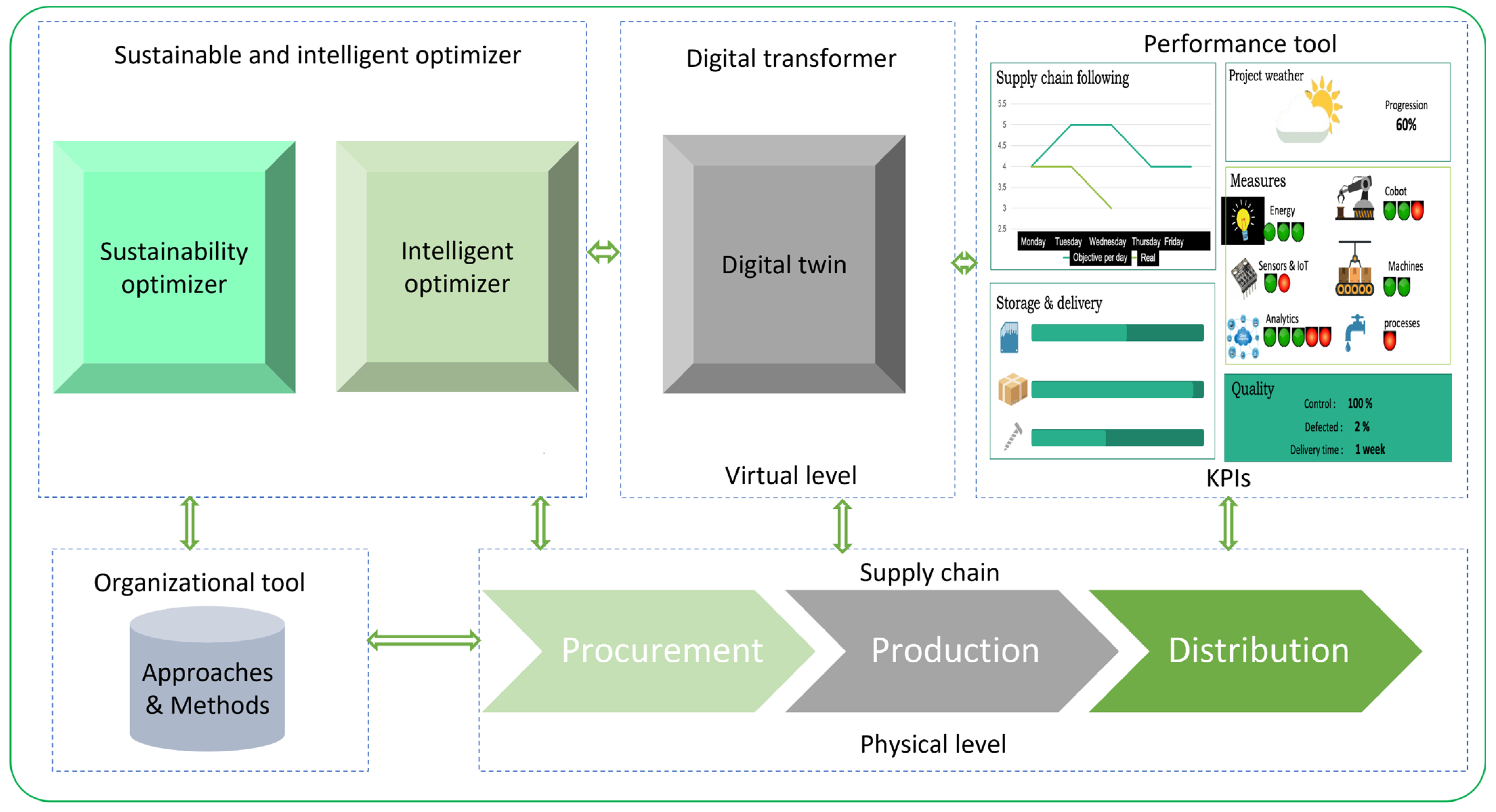
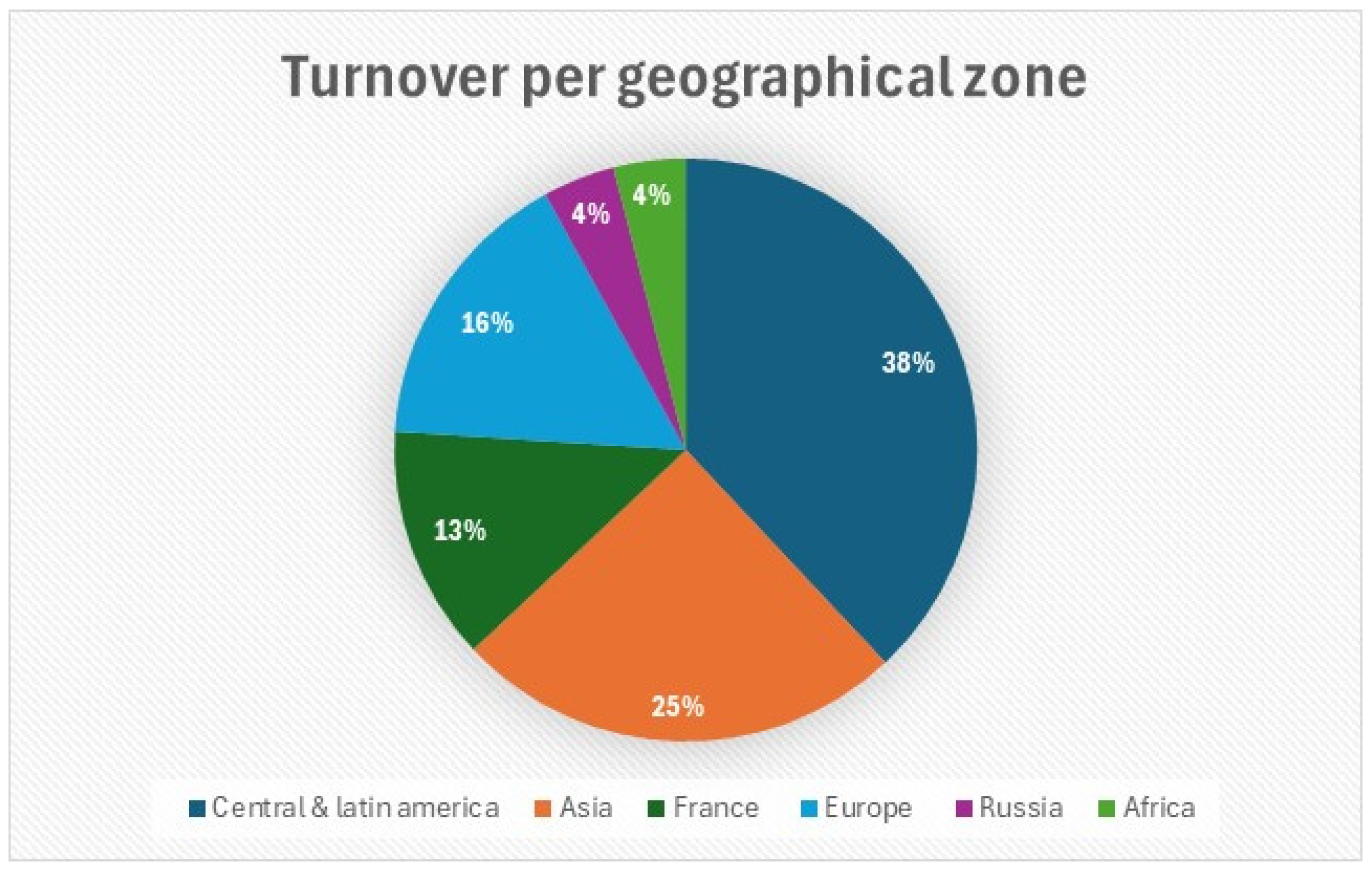

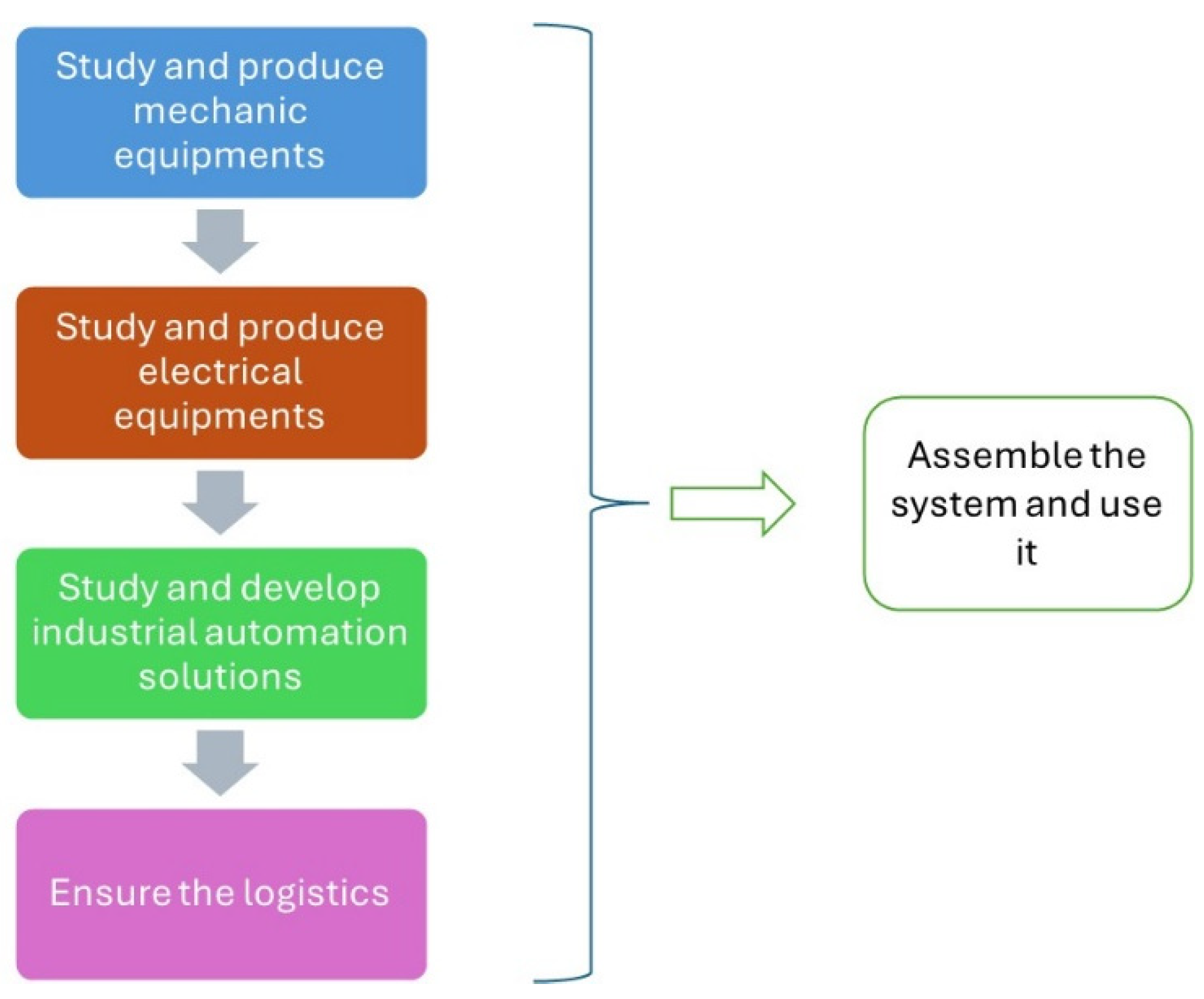
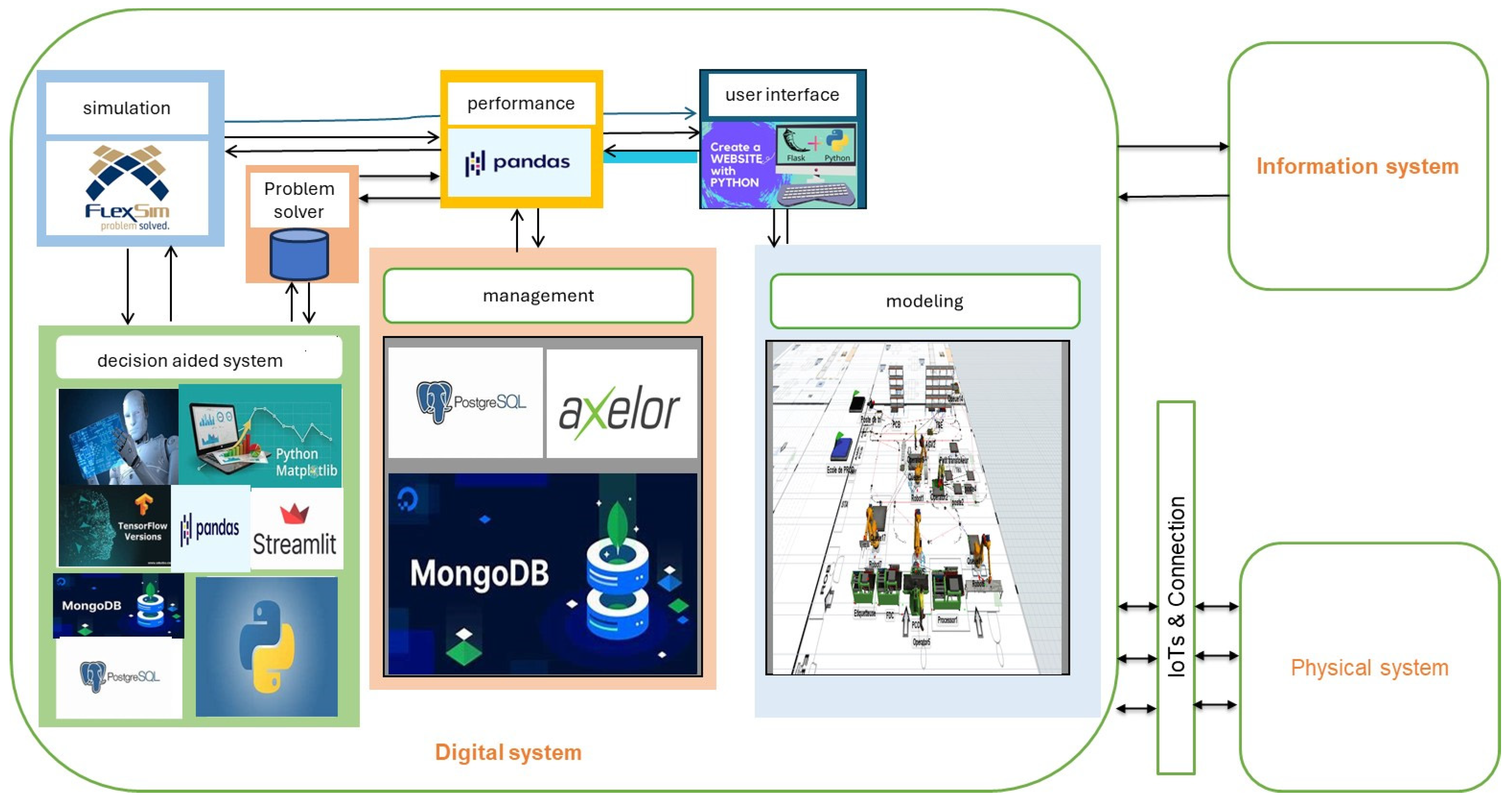
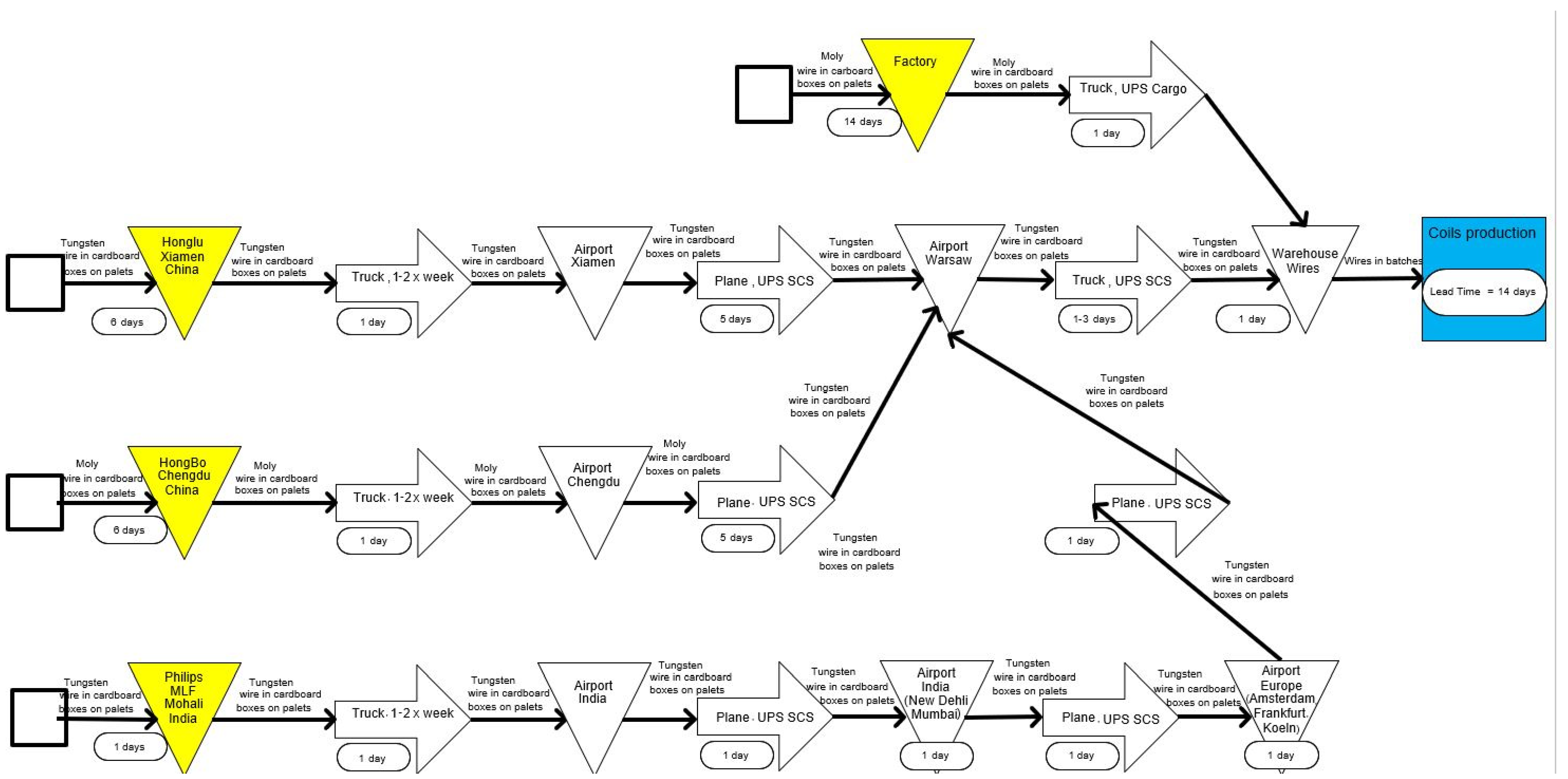



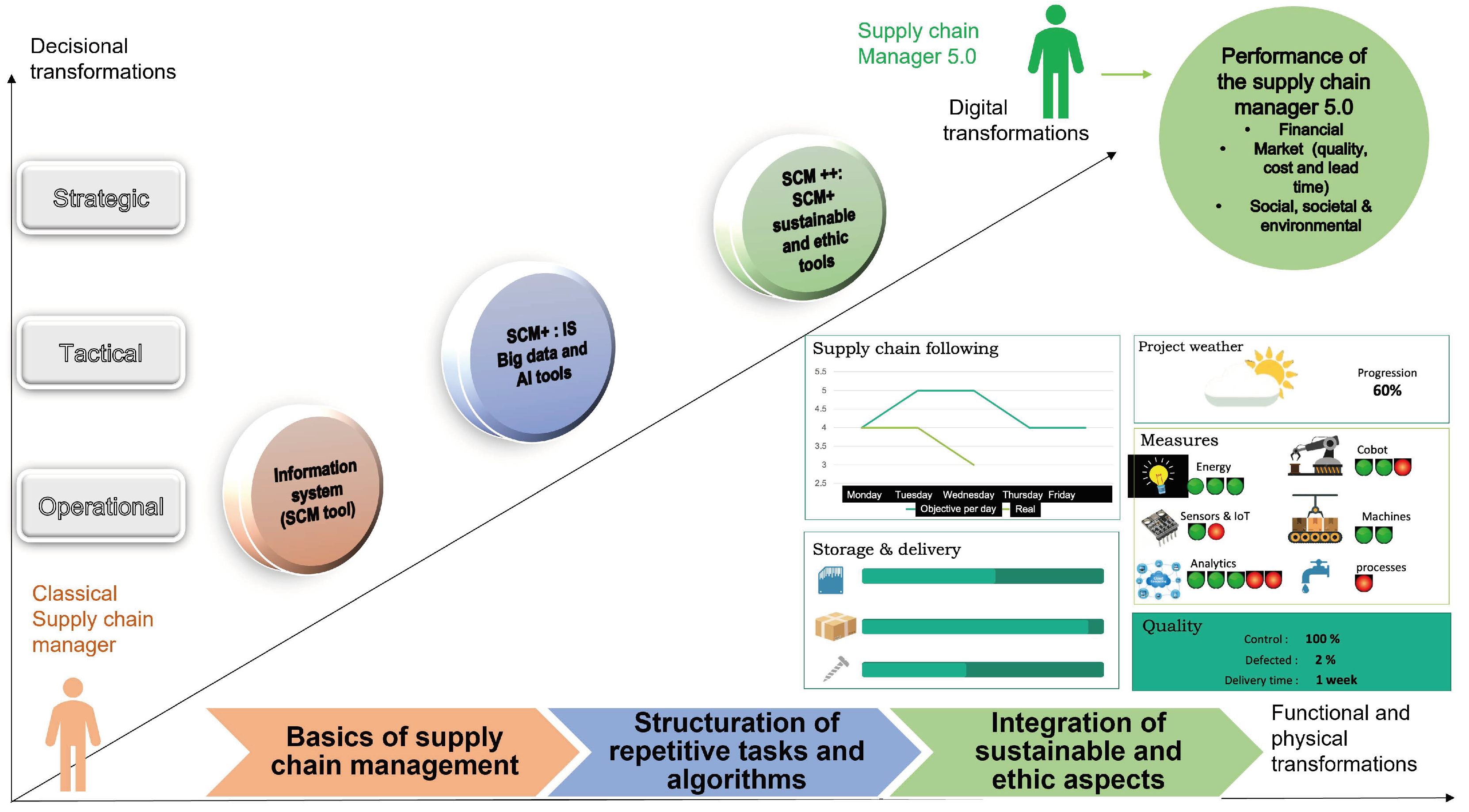

| Waste Stream | Recycling Rate | Strategy/Directive |
|---|---|---|
| Plastics | 32.5% | EU Strategy for Plastics in the Circular Economy |
| Textiles | 1% | EU Strategy for Textiles |
| E-waste | <40% | WEEE Directive |
| Food | 20% 1 | EU Farm-to-Fork Strategy |
| Water and nutrients | 90% 2 | Water Framework Directive |
| Packaging | 64% | Packaging and Packaging Waste Directive |
| Batteries and vehicles | 47% 90.5% | Batteries and Accumulators Directive End-of-Life Vehicles Directive |
| Buildings and construction | 50% | Energy Performance of Buildings Directive |
| Index | Description |
|---|---|
| i | Index of the procurement processes, i varying from 1 to I |
| j | Index of the manufacturing processes, j varying from 1 to J |
| k | Index of the distribution processes, k varying from 1 to K |
| l | Index of the cost criterion |
| m | Index of the quality criterion |
| n | Index of the lead time criterion |
| w | Index of the digital maturity degree criterion |
| o | Index of well-being criterion |
| p | Index of health criterion |
| q | Index of transport criterion |
| r | Index of waste criterion |
| s | Index of water criterion |
| t | Index of air criterion |
| u | Index of energy criterion |
| v | Index of environmental management criterion |
| Parameters | Description |
|---|---|
| Ni | Number of procurement processes |
| Nj | Number of manufacturing processes |
| Nk | Number of distribution processes |
| Cl | Cost minimization limit |
| Qm | Quality maximization limit |
| LDn | Lead time minimization limit |
| DMw | Digital maturity degree maximization limit |
| WBo | Well-being maximization limit |
| Hp | Health maximization limit |
| Trq | Transport minimization limit |
| Wstr | Waste minimization limit |
| Ws | Water minimization limit |
| At | Air pollution minimization limit |
| Enu | Energy minimization limit |
| EMv | Environmental management maximization limit |
| Decision Variables | Description |
|---|---|
| Xli | Unit Procurement cost |
| Xlj | Unit Manufacturing cost |
| Xlk | Unit Distribution cost |
| Xmi | Unit Procurement quality |
| Xmj | Unit Manufacturing quality |
| Xmk | Unit Distribution quality |
| Xni | Unit Procurement lead time |
| Xnj | Unit Manufacturing lead time |
| Xnk | Unit Distribution lead time |
| Xwi | Unit Procurement digital maturity degree |
| Xwj | Unit Manufacturing digital maturity degree |
| Xwk | Unit Distribution digital maturity degree |
| Yoi | Unit Procurement well-being |
| Yoj | Unit Manufacturing well-being |
| Yok | Unit Distribution well-being |
| Ypi | Unit Procurement health |
| Ypj | Unit Manufacturing health |
| Ypk | Unit Distribution health |
| Yqi | Unit Procurement transport |
| Yqj | Unit Manufacturing transport |
| Yqk | Unit Distribution transport |
| Dri | Unit Procurement waste |
| Drj | Unit Manufacturing waste |
| Drk | Unit Distribution waste |
| Dsi | Unit Procurement water |
| Dsj | Unit Manufacturing water |
| Dsk | Unit Distribution water |
| Dti | Unit Procurement air |
| Dtj | Unit Manufacturing air |
| Dtk | Unit Distribution air |
| Dui | Unit Procurement energy |
| Duj | Unit Manufacturing energy |
| Duk | Unit Distribution energy |
| Dvi | Unit Procurement environmental management |
| Dvj | Unit Manufacturing environmental management |
| Dvk | Unit Distribution environmental management |
| Semi-Finished Product | Min stock Level (Meters) | Real Average Stock | Simulated Average Stock Level (Meters) | Exceeded Stock Value kEuro |
|---|---|---|---|---|
| A1 | 270,000 | 7550,000 | 4200,000 | 4824.00 |
| E1 | 70,000 | 878,000 | 330,000 | 2220.00 |
| A2 | 12,600 | 80,000 | 39,000 | 1110.00 |
| E2 | 50,000 | 191,500 | 108,500 | 3170.00 |
| Total | 11,324.00 |
Disclaimer/Publisher’s Note: The statements, opinions and data contained in all publications are solely those of the individual author(s) and contributor(s) and not of MDPI and/or the editor(s). MDPI and/or the editor(s) disclaim responsibility for any injury to people or property resulting from any ideas, methods, instructions or products referred to in the content. |
© 2024 by the authors. Licensee MDPI, Basel, Switzerland. This article is an open access article distributed under the terms and conditions of the Creative Commons Attribution (CC BY) license (https://creativecommons.org/licenses/by/4.0/).
Share and Cite
Dossou, P.-E.; Alvarez-de-los-Mozos, E.; Pawlewski, P. A Conceptual Framework for Optimizing Performance in Sustainable Supply Chain Management and Digital Transformation towards Industry 5.0. Mathematics 2024, 12, 2737. https://doi.org/10.3390/math12172737
Dossou P-E, Alvarez-de-los-Mozos E, Pawlewski P. A Conceptual Framework for Optimizing Performance in Sustainable Supply Chain Management and Digital Transformation towards Industry 5.0. Mathematics. 2024; 12(17):2737. https://doi.org/10.3390/math12172737
Chicago/Turabian StyleDossou, Paul-Eric, Esther Alvarez-de-los-Mozos, and Pawel Pawlewski. 2024. "A Conceptual Framework for Optimizing Performance in Sustainable Supply Chain Management and Digital Transformation towards Industry 5.0" Mathematics 12, no. 17: 2737. https://doi.org/10.3390/math12172737
APA StyleDossou, P.-E., Alvarez-de-los-Mozos, E., & Pawlewski, P. (2024). A Conceptual Framework for Optimizing Performance in Sustainable Supply Chain Management and Digital Transformation towards Industry 5.0. Mathematics, 12(17), 2737. https://doi.org/10.3390/math12172737









